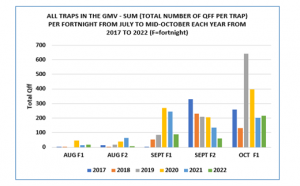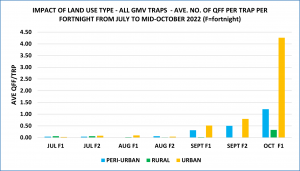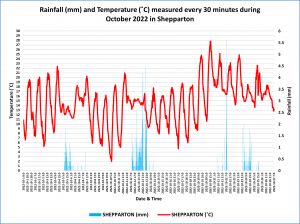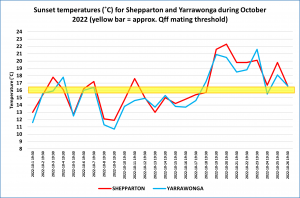This information has been commissioned by the Goulburn Murray Valley Area Wide Management Fruit Fly Program and is funded by the Victorian Government. Use of this material in its complete and original format, acknowledging its source, is permitted, however unauthorised alterations to the text or content is not permitted.
Current trap captures and population activity
A total of 216 Queensland fruit fly were trapped in the Goulburn Murray Valley regional trapping grid during the first half of October 2022. This compares with only 26 for August 2022 and 151 for September 2022. Now that spring has arrived and both daytime and night-time temperatures are rising more fruit fly are likely to be trapped. Fruit fly numbers for October 2022 are similar to those trapped at the same times in 2021 but less than for 2020 (Table 1 and Fig. 1). Totals, so far, for the current season (1 July to 30 June) for 2022/23 are much lower than for the past two seasons. In fact, 2022/23 to date, is the lowest in fruit fly numbers since the start of the GMV Regional Fruit Fly Project. Rain and cooler maximum temperatures have delayed the typical spring peak for trapped fruit fly. This occurred in 2021, too and both instances are due to La Niña weather conditions.
Table 1. Total Queensland fruit fly trapped in the GMV during July to mid-September from 2020 to 2022.
| Year | Sept wk1&2 | Sept wk3&4 | Oct wk1&2 |
| 2020 | 269 | 206 | 397 |
| 2021 | 245 | 135 | 204 |
| 2022 | 90 | 61 | 216 |
Table 2. Partial seasonal totals of Qfly from 2017/18 to current (2022/23).
| Activity season | Total (1 July to mid-Oct) |
| 2017/18 | 624 |
| 2018/19 | 439 |
| 2019/20 | 976 |
| 2020/21 | 979 |
| 2021/22 | 738 |
| 2022/23 | 427 |
Impact of flooding on Queensland fruit fly
Current flooding across the region is causing difficulties in accessing fruit fly traps. Traps are normally visited each week at this time of year to provide an indication of fruit fly presence and build-up. This information is used to plan area-wide management strategies for fruit fly control.
Fortunately, trapped flies will stay in traps until assessed and so actual numbers trapped will be retained and recorded once traps are accessible again.
Floods have little impact on fruit flies. In fact, they may benefit in some ways. For example, very wet weather will cause significant increases in relative humidity and, as a result, bacterial, fungal and yeast growth. These organisms are feed for adult fruit flies. Warm daily minimum temperatures associated with wet weather also favour the survival of adult fruit flies as well as eggs, larvae and pupae.
Queensland fruit fly eggs and larvae are susceptible to immersion in water, being killed in a matter of hours. If the water is shallow (less than 1cm deep) eggs and larvae may survive for over 24 hours. If eggs and larvae are inside infested fruit that has fallen on to the ground and are then flooded it will take several days (as many as 5 days) before water will penetrate fruit to impact eggs and larvae. In effect, flooding for fewer than 5 days will not impact egg and larval survival adversely.
Pupae are tolerant of flooding. Firstly they may float to the surface and then move to the edge of the water mass and survive as per normal. If forcibly immersed, pupae will survive for many hours. Laboratory experiments with pupae stored 10cm under water at 26˚C showed that 48% survived 3 days submersion and 7% survived 7 days under water. It was estimated that to achieve 100% mortality Queensland fruit fly pupae would need to be held under water for more than 8 days.
Adult flies are quite susceptible to being wet (i.e. caught in the rain). If the adult fly is sprayed with water the fly becomes immobile as the water sticks its wings together or to the surface on which the fly is resting. If this lasts for some time the insect becomes prey to birds, reptiles and other predatory insects. Sometimes, stuck flies die of starvation unless the weather warms up and dries them out. However, Queensland fruit fly have a very significant survival instinct and are well able to move away from falling water and into protective coverage.
Fig. 1

Sites of concern (potential hot spots)
There were five locations within the GMV where fruit fly numbers trapped were higher than the Goulburn Murray Valley average (0.87 Queensland fruit fly/trap/fortnight) during the first two weeks of October 2022 (Table 3).
Table 3. Potential fruit fly hot spots for October 2022 in the Goulburn Murray Valley
| COBRAM* | 1.18 Qfly/trap/fortnight |
| KYABRAM | 4.71 Qfly/trap/fortnight |
| MOOROOPNA | 3.64 Qfly/trap/fortnight |
| SHEPPARTON | 2.00 Qfly/trap/fortnight |
| TATURA | 3.67 Qfly/trap/fortnight |
*It should be noted that some of the fruit fly trapped in Cobram urban may be previously released sterile fruit fly that have survived the winter.
If you live in or near these locations, place monitoring traps out and check any nearby ripening, ripe or overripe fruit within the vicinity for the presence of fruit fly. In the Goulburn Murray Valley it is best to start monitoring by the beginning of September 2022.
Peri-urban, rural and urban impacts on fruit fly
Generally, fruit fly populations in urban areas expand earlier in the season than in peri-urban and rural sites. This trend continued in 2022 (Fig. 2).
Fig. 2

Current weather
As usual from mid-August to mid-October, the weather warmed up with intermittent returns to wintry conditions. Minimum daily temperatures ranged from -1˚C to 12˚C from mid-August to mid-September and from about 2.5˚C (10 Oct) to as high as 17.9˚C (21 Oct) during October. Several spikes in minimum temperatures occurred within the Goulburn Murray Valley during October which were associated with rainfall (Fig. 3). Fruit fly trapping rates usually increase under these early spring conditions.
Fruit fly mating potential
Queensland fruit fly will only mate at sunset and if the temperature is above 16˚C. Mating conditions were met in several days during the first half of October but, from about 18 October all daily sunset temperatures were at or above the mating threshold (Fig. 4). This means that the first post-winter fruit fly generation, with the full-scale commencement of egg-laying, will start in about 6 to 8 weeks from now.
Fig. 3

Fig. 4

Weather outlook
The Bureau of Meteorology outlook for the GMV for November 2022 (http://www.bom.gov.au/climate/outlooks/#/overview/summary/ ) suggests that:
- RAIN – a 75% to 80% chance of higher than average (10mm to 25mm) rainfall.
- MAX TEMP – less than a 25% chance that maximum daily temperatures will be above the average (24˚C to 27˚C). If there is a variation it will be between 0˚C and 1˚C cooler than average across the GMV.
- MIN TEMP – a 60% to 75% chance that daily minimum temperatures will be higher than average (9˚C to 12˚C) but only by between 0˚C and 1˚C warmer than average.
Fruit fly outlook
Higher than usual rainfall and daily minimum temperatures and neutral maximum temperatures indicate highly favourable conditions for overwintering adult fruit fly to emerge from their winter refuges and find fruit to infest. This is especially the case as mating thresholds are being achieved every day now. Prediction for a third consecutive La Niña event for late 2022 and early 2023 have been made.
- Fruit fly management programs and strategies in place early in spring 2022 and followed throughout the season will keep fruit fly activity under control.
- The importance of whole-of-community ownership awareness and participation cannot be understated.
Goulburn Murray Valley Area Wide Management Fruit Fly Program
For assistance in managing fruit fly, contact the Project Coordinator at the Goulburn Murray Valley Fruit Fly Office by phoning (03) 5871 9222 or email gmvfruitfly@moira.vic.gov.au.
This report was produced and supplied by Janren Consulting Pty Ltd for the purpose of the Goulburn Murray Valley Fruit Fly Program. The Goulburn Murray Valley Fruit Fly Area Wide Management Program is supported by the Victorian Government.
